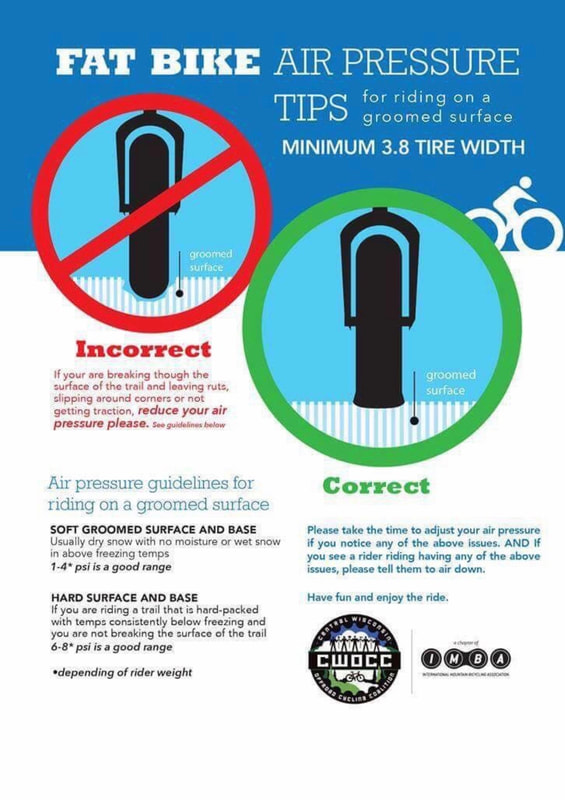Fatbike FAQ's
-Tire Pressure
Think before you sink! The softer the trail, the lower the pressure. If you're leaving ruts or losing traction, lower your pressure. The smaller the tire (ex. 3.5), the lower the pressure should be. The bigger the tire the higher the pressure. Adjust accordingly to reduce bouncing.
-Tire Width
3.5" or above.
Riding groomed trails: never ride freshly groomed trails. they need time to set up. most trails need 24hrs to become firm enough to ride. the more twists & turns on the trail require more patience and care.
-What trails should I ride?
Only ride designated trails approved for fatbiking. Always ride on the firmest part of the trail. If riding on ski trails never ride in the classic groove.
-Attire
Generally you should dress as you would for any outdoor activity. Wear wicking fabrics next to your skin and several breathable layers. Be sure to not over dress in order to minimize perspiration and eliminate moisture. We will suggest specific layers in more detail below.
Base layer:
Mesh or merino shirt
Thermal knickers with chamois
Wool socks
Thermal layer:
Merino wool top
Wool thermal pant
Vest
Wool hat with ear cover
Neck warmer "buff"
Outer layer:
Helmet
Goggles/glasses
balaclava
Insulated/waterproof jacket
Gloves
Windproof pant
Riding boot
shoe covers insulated covers
-Tire Pressure
Think before you sink! The softer the trail, the lower the pressure. If you're leaving ruts or losing traction, lower your pressure. The smaller the tire (ex. 3.5), the lower the pressure should be. The bigger the tire the higher the pressure. Adjust accordingly to reduce bouncing.
-Tire Width
3.5" or above.
Riding groomed trails: never ride freshly groomed trails. they need time to set up. most trails need 24hrs to become firm enough to ride. the more twists & turns on the trail require more patience and care.
-What trails should I ride?
Only ride designated trails approved for fatbiking. Always ride on the firmest part of the trail. If riding on ski trails never ride in the classic groove.
-Attire
Generally you should dress as you would for any outdoor activity. Wear wicking fabrics next to your skin and several breathable layers. Be sure to not over dress in order to minimize perspiration and eliminate moisture. We will suggest specific layers in more detail below.
Base layer:
Mesh or merino shirt
Thermal knickers with chamois
Wool socks
Thermal layer:
Merino wool top
Wool thermal pant
Vest
Wool hat with ear cover
Neck warmer "buff"
Outer layer:
Helmet
Goggles/glasses
balaclava
Insulated/waterproof jacket
Gloves
Windproof pant
Riding boot
shoe covers insulated covers
